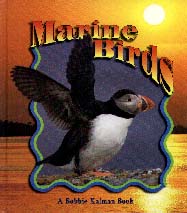|
________________
CM . . . .
Volume V Number 12 . . . . February 12, 1999
The young researcher looking for pictures of and information about
albatrosses, boobies, cormorants, gannets, pelicans, penguins and puffins
will be delighted to use this source. Colourful photos and detailed
descriptions come together to introduce the eating habits, and the
breeding, nesting and survival techniques of birds that live on, in, or
near salt water. A team of some 15 editors, writers, consultants,
illustrators and photographers have collaborated to produce Marine
Birds, one of the titles in the "Birds Up Close" series.
Although the content is quite useful, there are some discrepancies in the
way the mechanics of the presentation are handled. The index, for example,
leaves much to be desired as a really useful "tool" for accessing
information and/or pictures included in the body of the book. A reader
looking for a "willet" would be disappointed by the lack of reference in
the index, but a browse through the book would happily reveal a beautiful
photograph of a willet on page 5. Similarly, a seeker of information on
the family of seabirds known as "tubenoses" would be frustrated by looking
at the index, as the editors missed indexing a half-page article and photo
on page 7. Interestingly, the word "fulmar" warrants two points of
reference in the index, and yet it appears only as a single word in text
on each occasion, with no supporting material to explain the term.
Another somewhat disturbing feature of this book, and one which recurs in
the other two books in this series which this reviewer studied (Raptors
and Rainforest
Birds), is the inconsistent 'agreement' of some nouns and pronouns
and their antecedents. On page 6, a sentence quite correctly reads, "They
have special legs, feet and bills." On page 7, the sentence "All birds
have a beak" appears. The antecedent of the plural 'birds' should be
'beaks' or 'bills', not the singular 'beak'. Even in the headline "Ruining
their habitat" (p. 30), the plural 'their' is combined with the singular
'habitat' while the text refers to many 'habitats' which are being
destroyed.
Inconsistencies in the use of highlighted words in the text and
highlighting the first letters of some words in the index offer some
confusion to the reader, as there is no explanation of why highlighting is
used as an editorial technique. There does seem to be a link between some
of the highlighted terms and the terms which have been chosen for
inclusion in the glossary, but it is not consistent.
Despite these technical shortcomings, this book is certainly worth
including in any science collection serving elementary school-age
children.
Recommended.
Bob Piper is a semi-retired teacher-librarian living in Winnipeg, Manitoba.
To comment on this title or this review, send mail to cm@umanitoba.ca.
Copyright © the Manitoba Library Association.
Reproduction for personal use is permitted only if this copyright notice
is maintained. Any other reproduction is prohibited without
permission.
Published by
TABLE OF CONTENTS FOR THIS ISSUE - FEBRUARY 12, 1999.
AUTHORS |
TITLES |
MEDIA REVIEWS |
PROFILES |
BACK ISSUES |
SEARCH |
CMARCHIVE |
HOME
|

